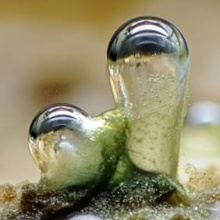Important Results
1) The shallow water zone is the main source for diffusive methane (CH4) emissions from lakes and reservoirs.
2) The largest fraction of the CH4 emissions from the Schwarzenbach reservoir is due to ebullition fluxes. The pumped-storage operation causes an increase of CH4 bubble release, which are minimal if the pumped-storage operation is performed on a daily basis.
3) During reservoir flushing, CH4 stored in the pore water of the sediment is released. The potential CH4 emissions due to reservoir flushing can be substantial, but can be minimized if the reservoir is flushed during spring.
4) Pumped-storage operation with a deep water input prevents the development of anoxic conditions and the accumulation of CH4 in the deep water.
5) Primary production causes the Schwarzenbach reservoir to become a sink of atmospheric carbon dioxide (CO2) during the summer months. For improving the quantification of the CO2 budget we developed and compared several open-water methods for the estimation of metabolic rates.
Brief summary
Motivation: Hydropower is considered as green energy. The reservoirs that are necessary for the generation of hydropower, on the other hand, represent a source for the greenhouse gases (GHG) CH4 and CO2 und emit these into the atmosphere. However, the magnitude of reservoir emissions and the influence of reservoir operations has not been sufficiently investigated yet.
Novelty: GHG concentrations, bubble fluxes and abiotic conditions were measured in reservoirs at high temporal resolution over seasonal time scales to investigate the effect of reservoir management on GHG emissions.
Strategy: Continuous in-situ measurements over several months and process oriented field campaigns in several reservoirs.
Methods: Deployment of autonomously measuring instruments (bubble flux funnels, CO2, CH4, O2 and T sensors), spatially resolved field measurements, water sample analysis, pore water analysis.
Expected results: Quantification of GHG emissions (CH4 und CO2) from reservoirs considering especially the effects of reservoir management and management strategies, as well as the implications of metabolic rates due to phytoplankton.
(A) Motivation: Hydropower is considered as green energy and plays, for concepts of energy supply with renewable energy sources, an important role as energy storage. However, the generation of hydropower requires reservoirs; and these can act as storage for a large portion of the terrestrial carbon that is introduced into aquatic systems. Consequently, reservoirs have been identified as an important source of atmospheric GHG in the global budget. However, the quantity and main pathways of emissions from reservoirs (mid-latitude systems) are still under debate and the influence of reservoir operations on GHG emissions has not been investigated in detail yet.
(B) Aims: The main objectives were to quantify CH4 and CO2 emissions in reservoirs and to investigate the significance of different emission pathways. In particular, the central question was how operational and environmental conditions (e.g. stratification, seasonal changes in temperature and dissolved oxygen, wind forcing, trophic conditions) influence CH4 and CO2 emissions as well as the carbon budget of mid-latitude reservoirs. Additionally, the estimation of the released amounts of CH4 during reservoir flushing was a major focus. Regarding CO2, the aim was to assess (1) how annual CO2 emissions in the tributaries compare to the carbon release from the reservoir on an annual time scale, (2) during which seasons reservoirs are a net-source or net sink of CO2 and (3) how much inorganic carbon is fixed by primary production.
(C) Methods: Continuous measurements with moored instruments (thermistors, O2 optodes, pH sensors, acoustic current profiler), i.a. also with automatic bubble collectors, regular water sampling and vertical profiling with probes (CTD and multi-fluorescence) in the reservoir as well as in its in- and outflows. These measurements provide seasonal information on the vertical distribution of CH4 concentrations, bubble fluxes, inorganic and organic carbon, chlorophyll a, the main phytoplankton “groups” and abiotic conditions (O2, temperature, turbidity, light). Realization of specific field campaigns, e.g. to investigate CH4 release during overturn and to determine the spatial distribution of CH4 concentrations in relation to the resuspension potential of sediments. Measurements of CH4 concentrations in the pore water of sediments, in order to estimate the potentially released CH4 during reservoir flushing.
(D) Achievable Goals: Overall, the intention of the studies was to improve the estimation of GHG emissions and the understanding of GHG pathways of mid-latitude reservoirs. A major goal was to provide a simultaneous quantification of the emissions of the two most relevant gases CH4 and CO2 in relation to abiotic and biotic conditions as well as reservoir operations. Furthermore, the effect of metabolic rates due to phytoplankton on the release and uptake of CO2 and the carbon budget in a reservoir was investigated. The conclusions serve as contribution to the evaluation of benefits and drawbacks of reservoirs and also support decisions with respect to catchment management and reservoir operations as well as construction.


